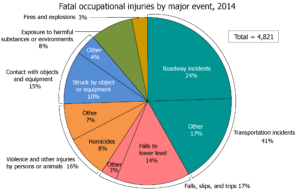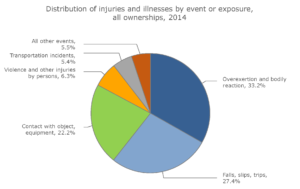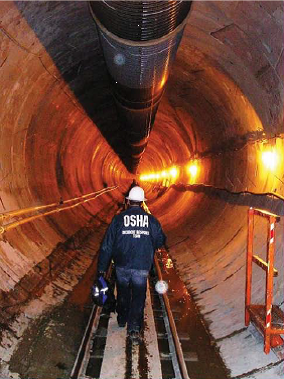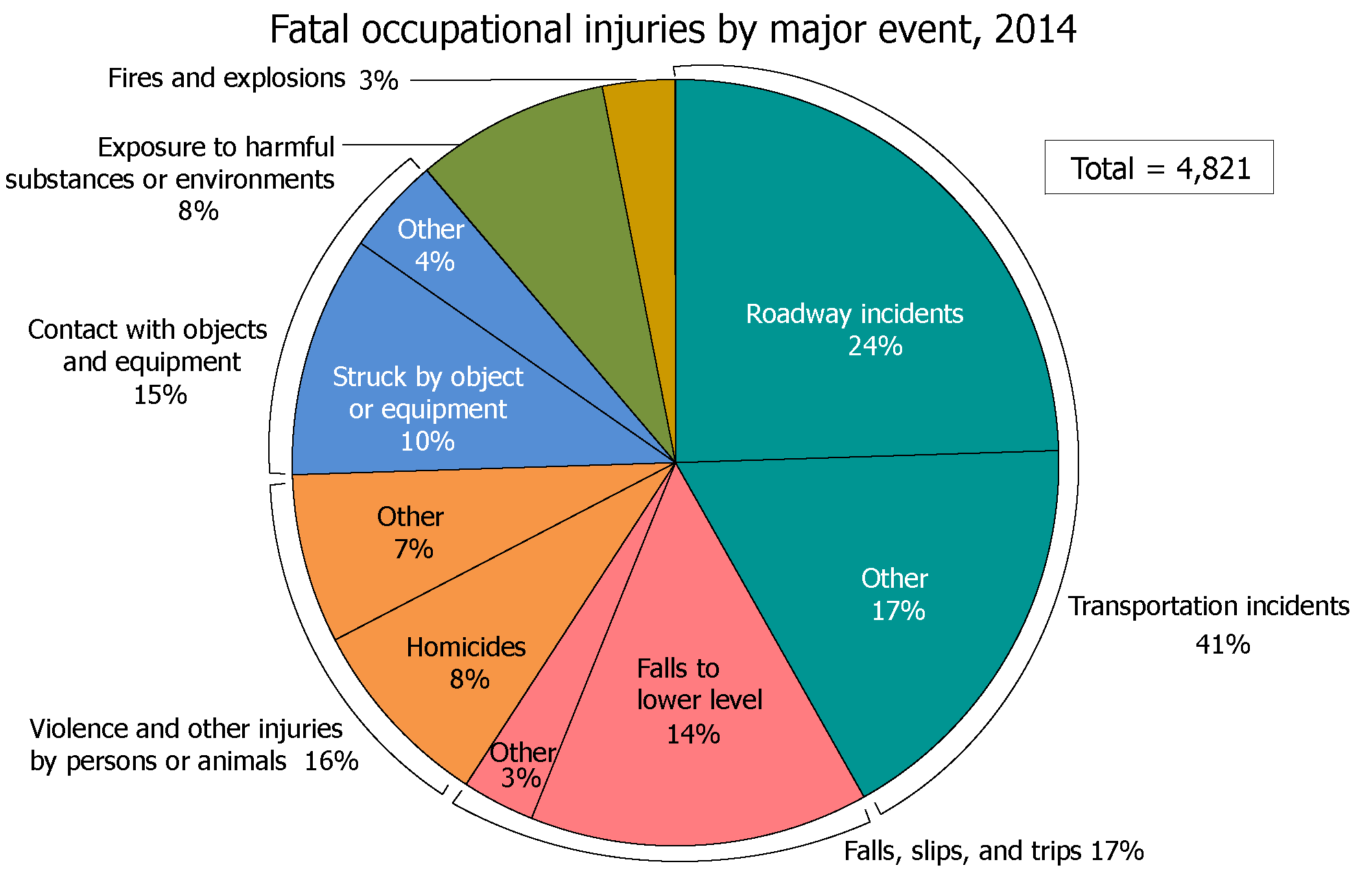“If all employers simply corrected the top 10 hazards, we are confident the number of deaths, amputations and hospitalizations would drastically decline.” Tom Galassi, director of enforcement programs for OSHA
About this time every year, the Occupational Safety and Health Administration publishes its top 10 list of regulatory violations and the Bureau of Labor Statistics separately begins to publish annual statistics on injuries, illnesses, and fatalities in the work place for the prior year. On October 27, 2016, the BLS issued a press release that summarized the statistics for non-fatal injuries in 2015; they are planning a release on statistics for fatal injuries in 2015 on December 16, 2016.
In OSHA’s release, the director of enforcement programs has suggested that the top 10 OSHA compliance issues are the top 10 hazards in the workplace. The conclusion is that reducing non-compliance will reduce serious injuries and fatalities. A look at actual injuries and fatalities in the workplace tells a somewhat different story. The most frequent regulatory violations are not as related to actual hazards in the workplace as one might believe.
OSHA’s 10 most frequently cited safety and health violations
This data is from almost 32,000 inspections conducted by federal OSHA staff during the past fiscal year, so it does not include data from state OSHA inspections. (Over half of all states run their own OSHA program in lieu of a federal OSHA program.) These are the top ten areas for citations:
- Fall protection
- Hazard communication
- Scaffolds
- Respiratory protection
- Lockout/tagout
- Powered industrial trucks
- Ladders
- Machine guarding
- Electrical wiring
- Electrical, general requirements
Bureau of Labor Statistics
To understand actual injury, illness, and fatality rates, we must look to the BLS, an agency in the Department of Labor that is completely separate from OSHA. The BLS characterizes their data a number of ways, which allows analysts to slice and dice however they need to tease out important conclusions. One of the characterizations is by event or exposure. The BLS groups all incidents into one of seven major categories of event or exposure. The distribution of workplace fatalities does not vary much from year to year. Here is the fatal injury data for 2014:

Year after year, transportation incidents account for over 40% of work-related fatalities. Year after year, slips/trips/falls, workplace violence, and contact with objects tie for second leading cause of fatalities, with each at around 15~20%. Year after year, exposure to harmful substances or environments, which includes drowning and electrocution, account for less than 10% or work-related fatalities and fires and explosions account for around 3% of work-related fatalities. The seventh category, overexertion and bodily reaction, never even makes the list. Apparently, we do not strain ourselves to death.
OSHA does not regulate two of the leading causes of work-related fatalities, transportation and workplace violence. Addressing the areas for citations is not going to have an impact on these causes. That means that addressing areas for citation is not about addressing the main hazards; more likely, addressing areas for citations simply serves to reduce the likelihood of being cited. Not that avoiding citations is unworthy; it is just that it should not be confused with having a drastic impact on hazards.
BLS injury rate data
Non-fatal injury rates in relationship to one another differ from fatal injury rates. Where overexertion and bodily reaction leads to no work-related fatalities, they are the leading causes of lost-time injuries. On the other hand, where transportation incidents are the leading cause of work-related fatalities, they are a relatively minor cause of lost-time injuries, with only “exposure to harmful substances or environments” and “fires and explosions” ranked lower.

The BLS breaks the seven major categories into subcategories and reports that data as well. Expressed in incidents per 10,000 full-time equivalents, here are the top BLS incidence rates for lost-time injuries in 2014:
- 36 – Overexertion and bodily reaction
- 29 – Slips, trips, and falls
- 24 – Contact with object, equipment
- 19 – Fall on the same level
- 13 – Struck by object, equipment
- 11 – Overexertion in lifting or lowering
- 6 – Transportation incidents
- 6 – Struck against object, equipment
- 5 – Fall to lower levels
Miscellaneous types of events account for the remaining 20 incidents per 10,000 workers.
Contradictions between the OSHA Top 10 and the BLS list of events
Whether looking at non-fatal injuries or fatal injuries, there is something of a disconnect between the events that jeopardize the safety of workers and the citations that OSHA issues. The leading event or exposure leading to lost-time injuries is overexertion and bodily reaction, an exposure that is not addressed by any of OSHA’s top 10 citations. Likewise, overexertion in lifting or lowering (BLS No. 6) and transportation incidents (BLS No. 7) are also not addressed by any of OSHA’s top 10 citations.
Looking at OSHA’s top 10 citations, four have little or nothing to do with the hazards that actually result in injuries or fatalities. Hazard communication (No. 2), respiratory protection (No. 4), and electrical safety (No. 9 and No. 10) are all citations related to particularly technical regulations, regulations with which it is apparently easy to fall out of compliance, but not necessarily regulations that are related to the greatest hazards in the workplace. This is not to say these regulations are unimportant; rather, these appear to be regulations for which it is easy to cite violations.
Where there is no contradiction: Falls and Contact with Objects
While there is certainly contradiction between enforcement priorities and the hazards actually experienced, there are two exposures where the two lists are in solid agreement. The first regards slips, trips, and falls. The second regards contact with objects and equipment.
The leader of the OSHA top 10 is fall protection. However, the OSHA top 10 also lists citations regarding slips, trips, and falls two more times: scaffolds (No. 3) and ladders (No. 7). The BLS identifies slips, trips, and falls as its second leading cause of lost-time injuries, accounting for 27.4% of all lost-time injuries, and as its second leading cause of work-related fatalities, accounting for 17% of work-related fatalities. Clearly, reducing injuries and fatalities as a result of falls by assuring adequate fall protection and the proper use of scaffolds and ladders is essential, not only to reducing citations, but to improving the safety of the workplace.
Contact with objects and equipment also appears on all of the lists. According to the BLS, contact with objects, whether running into objects, being hit by objects, or being crushed, mangled, or maimed, is the third leading cause of lost-time incidents, accounting for 22.2% of injuries. It is also a leading cause of work-related fatalities, year after year being in a three-way tie for the second leading cause of death in the workplace. The regulations that OSHA has put into place to protect against contact with objects are the three of the 10 most frequently cited for violations: Lockout-Tagout (No. 5), Powered Industrial Trucks (No. 6), and Machine Guarding (No. 8). Whether protecting workers from equipment while it is being maintained (lockout-tagout), while it is being operated (machine guarding), or while it is being moved from place to place, we are not doing a good enough job.
Compliance and Safety
Sometimes we do things because they make our workplace compliant with safety regulations. Sometimes we do things because they make our workplace safer. And sometimes they are the same thing. By all means, make sure your workplace is complying with all relevant safety regulations. The fines that can be levied have gone up; any money spent paying a fine is money that cannot be spent to make your workplace safer. When it comes to making your workplace safer, however, look beyond OSHA’s top ten list to the hazards in your workplace that are actually resulting in injuries and fatalities. Tackle those. That’s where the real payoff will be.


